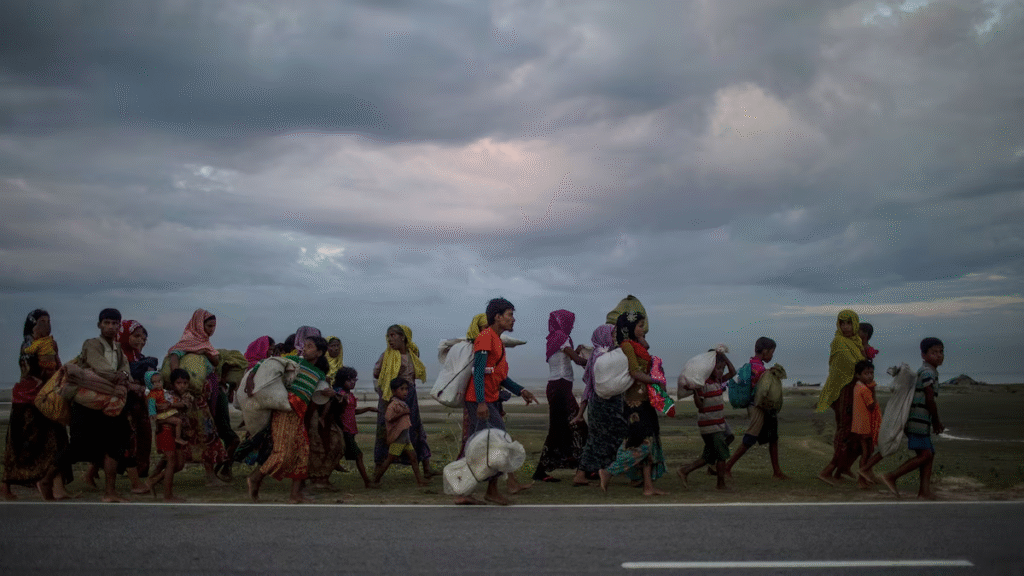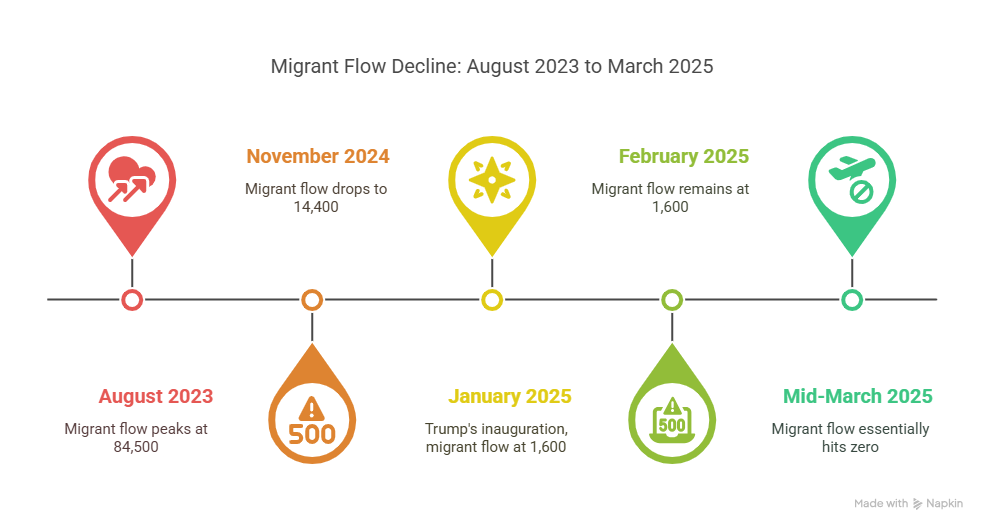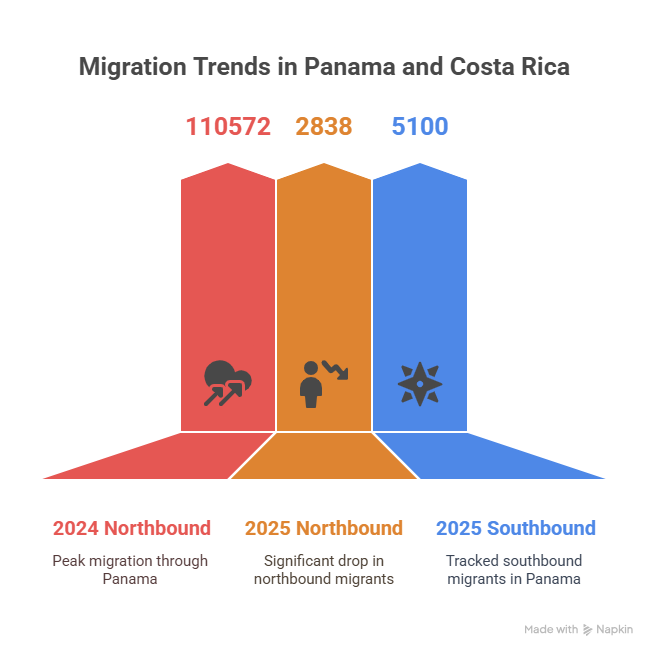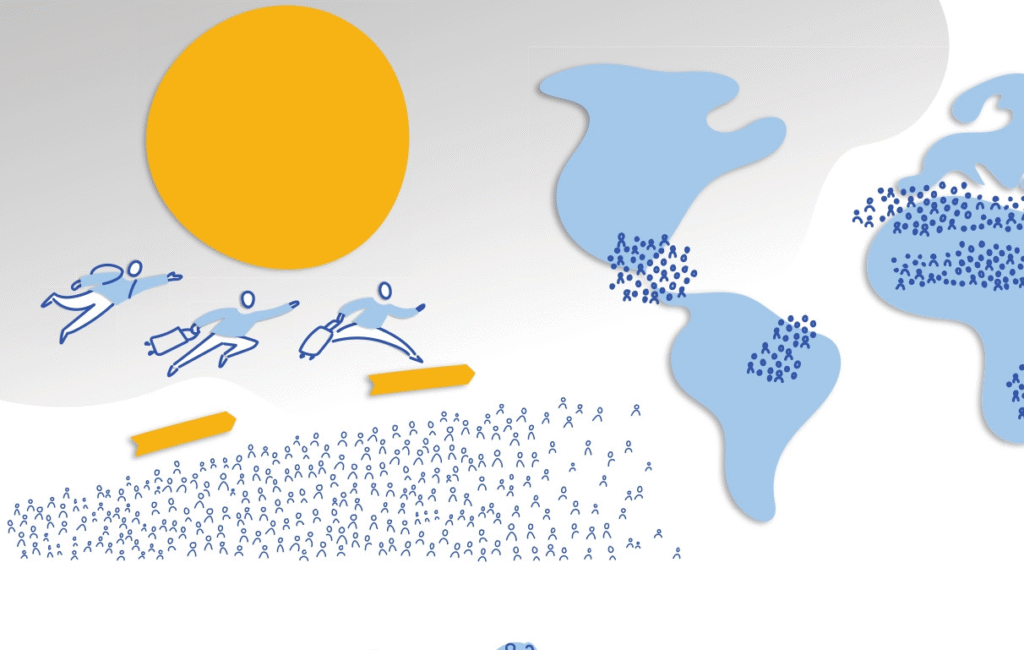A dirt road branches off from the main northern highway of Costa Rica, the one that connects the country to Nicaragua. Along this route lies the Las Tablillas border checkpoint, way of refugees.
When heavy rains cause the Rio Frio river to overflow, the low-lying forestlands surrounding it become flooded. At such times, the dirt road turns into a thick, sticky trail of mud. The mud becomes so adhesive that it grips the shoes of migrants trying to cross the border. Many of them, after making it across, abandon their worn-out sneakers by the roadside.
Last month, Justin Gest, a migration researcher, visited the area. He saw hundreds of discarded shoes—sun-bleached and coated in dust. But what struck him the most was their location: the shoes were all piled up on the southern side of the border. This suggested that those who wore them had traveled south from Nicaragua into Costa Rica.
This pile of shoes stands as a silent monument—a stark marker of a profound shift in human migration. For the first time in recent history, people traversing Central America are now moving predominantly southward.
This new migration pattern may be attributed to the strict border policies of the Trump administration in the United States, which has taken a hard stance on both legal and illegal entry. The effects of those policies are already being felt deep within Central America.

Over the past several years, millions of people from Latin America, the Caribbean, Asia, and Africa journeyed north through South America, risking their lives in the perilous Darién Gap, with the ultimate goal of reaching the United States via Panama. But that once-massive stream of northbound migration has now started to dry up.
Costa Rica serves as a vivid example of this shift. For years, hundreds—sometimes thousands—of migrants would travel each day by bus from Paso Canoas in the country’s southern border to Los Chiles in the north, a journey spanning nearly 300 miles.
According to data from the United Nations-backed International Organization for Migration (IOM), over 1.2 million people entered Costa Rica from Panama between 2021 and 2024 while heading north.
However, in August 2023, the number of refugees reached a peak of 84,500 and began to decline steadily. By November 2024, the figure had fallen to 14,400. In January 2025—the month Donald Trump was sworn in again as President of the United States—the number dropped to just 1,600. The same figure held in February. By mid-March, the flow of northbound migrants had essentially hit zero.
In contrast, the IOM reported that approximately 1,200 people had entered Costa Rica from the south over a six-week period spanning February and March.
This shift is no longer just a statistic—it has fundamentally altered the migratory landscape of Central America.
Countries like Guatemala and Colombia have also witnessed a reversal in migration trends. This year alone, those nations have recorded higher numbers of migrants traveling southward.
The Panamanian government reported that since the beginning of 2025, they have tracked around 5,100 southbound migrants. Like Costa Rica, Panama has seen a dramatic drop in northbound migration. During the first three months of 2024, 110,572 migrants headed north through Panama. In the same period of 2025, the number had plummeted to just 2,838.

However, Costa Rica’s IOM data is not always comprehensive. Migrants who cross during the night or on weekends are not included in their records, and not all entry points are monitored.
Last month, Justin spoke with more than two dozen migrants in Costa Rica. All but one had either halted their northbound journey or returned from Mexico. Many had been waiting there for interviews with U.S. immigration officials—appointments that never materialized.
To accommodate this new flow of migrants, bus companies have begun offering additional southbound routes from Los Chiles to cities such as Quesada and the capital, San José.
At the bus terminals in Los Chiles and Las Tablillas, Justin also encountered people known as “coyotes”—smugglers who facilitate human trafficking. These coyotes, who once guided migrants north, are now offering services to help migrants return south.
Most of the migrants were fully aware of the Trump administration’s anti-immigration stance. They had heard of people being deported from the United States. For many, that alone was reason enough to give up their journey north, convinced that entering the U.S. was no longer a realistic possibility.
Even during the Biden administration, certain restrictions had already led to a drop in asylum applications. But just hours after Trump’s inauguration, a significant shift occurred: he shut down a mobile app introduced under Biden that had allowed migrants to schedule interviews with immigration officers.
Some migrants reported waiting up to nine months for these interviews. When they learned the appointments had been canceled, many decided to turn back.
There are still a few attempting to cross the U.S. border illegally, but doing so now requires a hefty sum of money—an amount most migrants simply cannot afford.
According to a recent report by El País, the cost for a migrant to be smuggled into the U.S. from Tijuana, Mexico, ranges from $6,000 to $10,000.
Migrants say that another powerful factor behind the southward migration—beyond Trump’s re-election—is the dangerous conditions they face while waiting for asylum in Mexico.
In January 2024, with assistance from U.S. officials, the Mexican government began forcibly relocating migrants from border areas. In Mexico’s southern region, many corrupt officials turn a blind eye to drug cartel violence. Criminals routinely abduct migrants and extort money from them. Those believed to have relatives in the U.S. are especially targeted. Many migrants have said that the dangers they faced in Mexico were worse than those they had fled in their home countries.
One such migrant is Abismael, a 25-year-old Venezuelan auto mechanic. He chose not to reveal his full name for fear of retaliation.
Until recently, he worked at a garage in Tapachula, Mexico. In exchange for food and shelter, he worked 12-hour days, seven days a week—for a mere $15 weekly stipend.

Earlier this year, he, along with his brother, sister-in-law, and five nieces and nephews, were kidnapped by armed cartel members. With a gun pressed to his back, Abismael was repeatedly threatened and told: “Plata o plomo”—“Pay up or take a bullet.” At one point, a kidnapper screamed at his four-year-old nephew: “May your mother die—give me my money!”
They were eventually released after Abismael’s mother sold the family refrigerator in Caracas, Venezuela, and wired the ransom money.
Justin met Abismael at the Los Chiles bus terminal, about three miles south of the Nicaragua border. There, he was tossing a plastic baseball to his nephew, who was using a tree branch as a bat.
With local shelters at full capacity, the family now spends their nights in a corridor of a nearby market. Still, Abismael said they plan to apply for asylum in Costa Rica and hope to settle there permanently.
“When we crossed into Costa Rica after leaving Mexico, I felt like I could finally breathe again,” he said. “The air just felt different. This place—it’s another world. We can walk on the streets. We’re given food, water, and access to restrooms. Honestly, all we want is peace. We’ll do whatever work we can—just honest work.”
For those heading south, Costa Rica has naturally emerged as a promising destination for asylum. It is a middle-income country and the only stable democracy in Central America.
Many migrants do not want to cross the treacherous Panamanian jungle again to return to South America. At the same time, the situation in other Central American nations—Guatemala, El Salvador, Honduras, and Nicaragua—remains just as perilous as in Mexico.
Here is your translated article in formal American English without any shortening, maintaining the original meaning and tone:
Preliminary results from an unpublished survey conducted by the International Organization for Migration (IOM) in Costa Rica reveal that 22 percent of southbound migrants intend to remain in the country. The remaining 73 percent plan to continue their journey further south.
Justin, a migration researcher, advises the Costa Rican office of the IOM on data collection without receiving any form of remuneration. As a result, he has access to the findings of their research.
Costa Rica is rapidly coming under strain. Last month, the country’s Deputy Minister in charge of immigration policy reported that the nation—home to approximately 5.1 million people—is currently processing asylum applications from over 200,000 individuals.
Officials from the IOM in Costa Rica have confirmed that the country’s asylum system is now experiencing a backlog of nine months. Not a single space is available in any of the country’s seven shelters.
The reverse migration flow that has started from Mexico could potentially intensify in the future. Between January and August 2024, Mexican authorities documented the presence of nearly 900,000 irregular migrants who were staying in the country without proper documentation. In the final three months of 2024 alone, Mexico’s security forces detained approximately 475,000 such migrants.
If a significant portion of this large population begins to head south in the coming months, it could trigger a humanitarian crisis in Costa Rica and other countries in Latin America. A similar situation occurred in 2019 when 60,000 Nicaraguans fled civil conflict and sought refuge in Costa Rica, overwhelming the country’s asylum infrastructure at the time.
Costa Rican officials acknowledge that they are not fully prepared for the current situation. In an interview with Justin at her office in San José, Badilla stated, “We are expecting a wave—a massive wave. We believe that migrants are currently scattered between Mexico and Nicaragua. But at some point, they will suddenly enter Costa Rica.”
She firmly stated that Costa Rica would have to declare a state of emergency when that happens, enabling the government to deploy national resources for the construction of temporary shelters, provision of food, medical assistance, clothing, and other necessities. She added candidly, “We simply do not have the capacity.”
The office of the country’s Ombudsman, responsible for human rights protection and government accountability, recently issued a scathing critique of some government shortcomings—particularly concerning the treatment of detained migrants and the confiscation of their passports and other personal documents.
Badilla expressed concern that if the United States begins to deport asylum seekers and send them southward, the ongoing humanitarian crisis in Costa Rica could deteriorate further. Still, she acknowledged that Costa Rica remains dependent on the United States for a range of matters, including security and public health.
In February 2025, Costa Rican President Rodrigo Chaves Robles stated that the country is prepared to cooperate with its “economically stronger northern brother” and would accept flights carrying deported migrants from the United States.
However, human rights lawyers have filed lawsuits against Costa Rica and Panama, alleging that these countries have violated the rights of detained migrants—including children—by holding them unlawfully. These cases are still under judicial review. Following these lawsuits, deportation flights from the United States have been suspended. Both Costa Rica and Panama, however, maintain that no one is being detained against their will.
Badilla, appointed by President Chaves, is a member of the centrist Social Democratic Progress Party, which came to power in the 2022 elections with a strong anti-corruption platform.

She noted that xenophobia is already beginning to rise in Costa Rica. She fears that, as the 2026 elections approach, her party may face political backlash stemming from anti-migrant sentiment. Just as centrist governments have collapsed in places like Europe and the United States, a similar fate could befall Costa Rica.
The Trump administration may find some satisfaction in the fact that many migrants are now turning back from their northward journeys. However, this could increase instability across Central and South America, ultimately harming U.S. interests.
If Costa Rica’s pro-U.S. government loses power, it could be replaced by a weaker administration—or one that is aligned more closely with China.
Meanwhile, with the U.S. asylum system effectively shut down, many migrants are left with no option but to attempt illegal entry through clandestine routes. This exposes them to greater exploitation by Mexico’s dangerous criminal networks—precisely the groups Trump vowed to crack down on during his campaign.
Trump’s policies are tarnishing the United States’ historic legacy. Once a symbol of refuge for the oppressed, offering sanctuary in the name of freedom and human rights, the country’s image is now under threat. As a result, other nations may also begin to violate international law and adopt harsher immigration policies.
Trump has declared that strict border controls will only be eased once the so-called “invasion” at the southern border ends. Yet, even as many migrants now turn back, a humanitarian crisis persists in the Western Hemisphere—and it is likely to continue.
